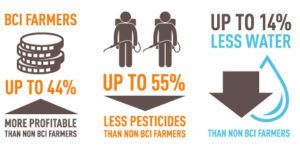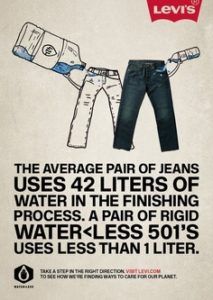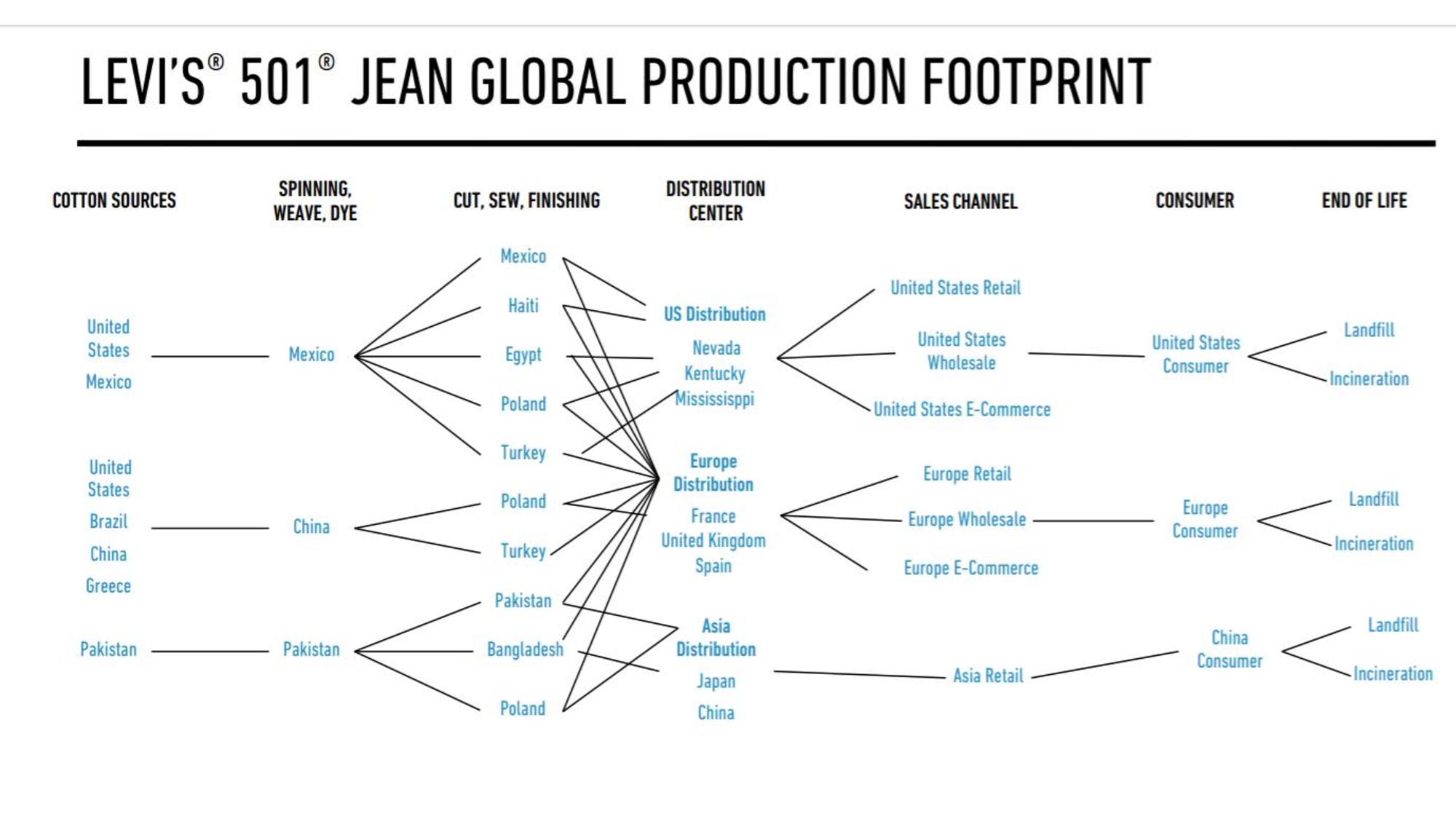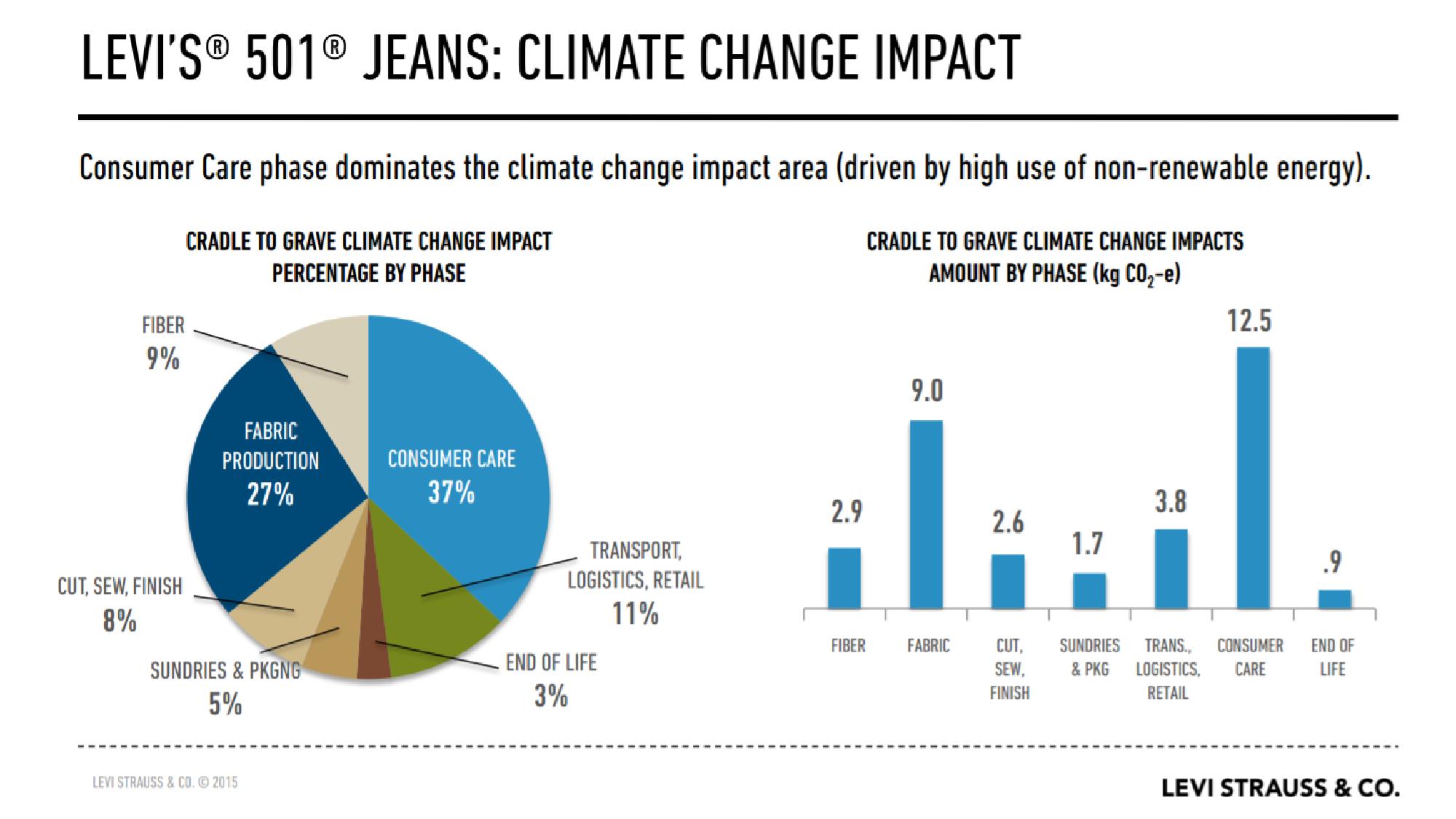So Hot Right Now! The Levi Strauss Climate Change Agenda

In 2012, Levi Strauss & Co., a denim jean retailer, created the “Climate Change Agenda” to address climate change head-on. The agenda focuses on achieving measurable progress combating climate change through operations, supply chain and education. While they clearly are a leader in the space, are they doing enough?
LEVI’S RESPONSES TO CLIMATE CHANGE

RESPONSE #1) Leadership in Energy and Efficient Design (LEED) Certifications
- Climate Threat: Inefficient use of resources in office buildings and distribution centers
- Business Impact of Climate Threat: Higher operating costs; wasting natural resources
- Solution Details: Remodeled San Francisco headquarters to LEED standards receiving Gold Certification[1] and retrofitted Nevada distribution center to LEED standards receiving highest Platinum rating, a first for a distribution center in the apparel industry.[2] 40% of Levi’s carbon footprint is from distribution,[3] so impact was significant
RESPONSE #2) Better Cotton Initiative

- Climate Threat: Agricultural commodities (e.g. cotton in 95% of Levi’s products[4]) compete with food crops as land and water become scarce leading to reduced cotton yields. Traditional agricultural practices promote additional climate warming (2.4% of world’s crop land devoted to cotton consumes 24% of the insecticides used in agriculture.[5])
- Business Impact of Climate Threat: Operating costs increase, production scarcity
- Solution Details: Pioneered a coalition of retailers and non-profit organizations adhering to sustainable cotton best practices. Principals include minimizing environmental impact, conserving natural resources, and promoting safe practices
RESPONSE #3) Water<Less™
- Climate Threat: Water is required in all phases of manufacturing process; as climate change intensifies water accessibility is decreasing
- Business Impact of Climate Threat: Operating Costs Increase
- Solution Details: Utilized innovative finishing techniques to decrease water use by up to 96%[6]. Since the Water<Less™ campaign launched in 2011 Levi’s has saved 1 billion gallons of water[7]

LEVI’S OPPORTUNITY TO DO MORE
Source closer to the point of sale. Jeans travel great distances from cotton sourcing through consumer purchase. Levi’s should look to identify efficiencies in the manufacturing and distribution process which will drive transportation costs down and lower the carbon footprint

Educate consumers. Levi’s conducted a study in 2015 on the life cyle of a jean and found that consumer care is the primary driver of Levi’s climate change impact and that washing a product 10 times it’s worn instead of every 2 times reduces energy use, climate change impact, and water intake by up to 80%[8]. While the study was produced in 2015, no major advertisments capitalized on the Water<Less™ campaign. Educating consumers will serve a twofold mission of both reducing climate change impact and driving sales. The Chief Sustainability Officer of Levi’s noted: “It’s certainly a competitive advantage if you communicate it properly to the consumer, and it’s something that consumers are more and more aware of and want[9]”

DOES THE CONSUMER WANT TO KNOW MORE?
As one writer described: “If “green” is the darling of eco-marketing, then “climate-friendly” is the egghead sister that no one wants to date. People don’t want to be saddled with the world’s problems when they are out buying jeans. In fact, consumer brands are more likely to risk alienating politically conservative consumers than they stand to gain in boosting sales for demonstrating leadership in corporate responsibility[10]”
Will reaching consumers help or hurt their mission of driving sales and creating a better planet?
[794 words]
[1] Levi Strauss & Co.. 2016. Planet – Climate Change – Sustainability. [ONLINE] Available at: http://levistrauss.com/sustainability/planet/climate-change/. [Accessed 4 November 2016].
[2] Levi Strauss & Co. Unzipped Blog . 2016. OUR LS&CO. DISTRIBUTION CENTER GOES LEED PLATINUM. [ONLINE] Available at: http://www.levistrauss.com/unzipped-blog/2016/01/our-lsco-distribution-center-goes-leed-platinum/. [Accessed 4 November 2016].
[3] Levi Strauss & Co. Unzipped Blog . 2016. OUR LS&CO. DISTRIBUTION CENTER GOES LEED PLATINUM. [ONLINE] Available at: http://www.levistrauss.com/unzipped-blog/2016/01/our-lsco-distribution-center-goes-leed-platinum/. [Accessed 4 November 2016].
[4] Levi Strauss & Co.. 2016. 2016 CARBON DISCLOSURE PROJECT CLIMATE CHANGE INFORMATION REQUEST. [ONLINE] Available at: http://www.levistrauss.com/wp-content/uploads/2016/07/2016_LSCO_CDP_REPORT_FULL.pdf. [Accessed 4 November 2016].
[5] Levi Strauss & Co. 2016. MAKING STRIDES THROUGH THE BETTER COTTON INITIATIVE. [ONLINE] Available at: http://www.levistrauss.com/unzipped-blog/2016/08/making-strides-through-the-better-cotton-initiative/. [Accessed 4 November 2016].
[6] Levi Strauss & Co.. 2016. Made of Progress . [ONLINE] Available at: http://www.levi.com/US/en_US/madeofprogress#process. [Accessed 4 November 2016
[7] Proquest Business Wire. 2015. Levi Strauss & Co. Reaches 1 Billion Liters of Water Saved Through Sustainability Initiatives; Releases New Environmental Impact Study on Apparel. [ONLINE] Available at: http://search.proquest.com.ezp-prod1.hul.harvard.edu/docview/1663882973?accountid=11311. [Accessed 4 November 2016].
[8] Levi Strauss & Co.. 2015. The Life Cycle of a Jean: Understanding the environmental impact of a pair of Levi’s ® 501 ® jeans. [ONLINE] Available at: http://levistrauss.com/wp-content/uploads/sites/4/2015/03/Full-LCA-Results-Deck-FINAL.pdf. [Accessed 4 November 2016].
[9] Better Cotton Initiative. 2015. BCI and Levi Strauss & Co: Better Cotton is Good for Business. [ONLINE] Available at: http://bettercotton.org/bci-and-levi-strauss-co-better-cotton-is-good-for-business/. [Accessed 4 November 2016].
[10] Triple Pundit: People, Planet, Profit / Mike Bellamente. 2012. Levi’s Quietly Announces Climate Change Strategy. [ONLINE] Available at: http://www.triplepundit.com/2012/10/levis-climate-change-strategy/. [Accessed 4 November 2016].
IMAGE SOURCES:
1) http://www.imdb.com/title/tt0196229/mediaviewer/rm602732288
2) http://www.reviewjournal.com/business/levi-strauss-distribution-center-honored-sustainability
4) http://levistrauss.com/wp-content/uploads/sites/4/2015/03/Full-LCA-Results-Deck-FINAL.pdf
5) http://levistrauss.com/wp-content/uploads/sites/4/2015/03/Full-LCA-Results-Deck-FINAL.pdf



Really enjoyed reading this! Nice pictures, helped a lot with understanding of details/processes. Got another idea to reduce climate impact/promote social responsibilities from the IKEA case, I think Levi’s can also recycle jeans. Probably not to use it to produce a new one but to donate it to people who need clothes in underdeveloped area or just homeless people in the local area where the clothes are collected. This reduce the pollution from landfill and incineration and help people in need at the same time.
great idea NN! They’ve already explored this; in 2009 they launched “a care tag for our planet” and partnered with Goodwill too champion donating clothes: http://adage.com/article/goodworks/levi-s-goodwill-launch-clothing-recycling-push/139856/ However I can’t find anything later than 2010 on it, so it may be good to relaunch the campaign
Great post! Retail companies are uniquely impacted by climate change as it impacts every part of their supply chain and beyond. I do think it is a risky tactic to drive sales with a climate change message, but I think a brand like Levis has the opportunity to make sustainability “cool.” I am not sure of the exact positioning of the “wash less” campaign you noted, but I think they could get pretty creative with this. Consumers might not actually want to wash their jeans as it is more work to do so! Levis could design a pair of jeans that is specifically meant to “get better with dirt,” encouraging people to wash less and wear more. It sounds like Levis could also consider new methods of transportation for their goods – I believe companies such as PepsiCo are piloting using hybrid and electric vehicles for distribution.
Well done, Emily Britt! I think Levi’s is an interesting choice for the assignment and appreciated the way you laid out the post. I had also thought when reading this that Levi’s could approach some type of lifetime guarantee or recycling program to incentivize customers to prolong the product lifetime and also create a channel of vintage denim that can be repurposed. Patagonia has a program that allows customers to return old or damaged clothing at any time. They then either repair or resell the product or recycle the material for something new. I agree with the previous post that Levi’s image of being vintage and durable but also hip would play well into these programs.
As for the LEED certifications, I wonder what their success has looked like in retail stores? I saw in my own research that reducing emissions in leased retail outlets is harder due to the parent company’s lack of control in the property itself.
Thanks for this post EB! It seems like Levis has some interesting initiatives to tackle the growing pressures that climate change will place on the business. I was especially interested in response #2 around the better cotton initiatives. It seems like there could be some parallels here with the Ikea wood sourcing case. While passing the burden of sustainability along to their suppliers is one approach, perhaps they could consider some of the options that Ikea was entertaining – purchasing their own agricultural resources and growing the cotton themselves (vertical integration), using cotton blend products with more sustainable resources (maybe a synthetic with low environmental impact), or as mentioned in previous comments, promoting recycling of used clothing and using that in some elements of products (they may already do this).
Interesting post! I was surprised Levis are taking initiatives for climate change. I was fascinated with response #3 about using less water in their manufacturing process. But as a consumer who wears jeans on a regular basis, I’m not sure if using water is actually better or not – does the quality of jeans go bad? What happens to the jeans if you don’t use the usual amount of water? What are these finishing techniques (alternative to water) in the manufacturing process that would enable Levis to maintain their quality? I wonder if it is at all possible for Levis to completely change their manufacturing process to the point where they only manufacture jeans using this new technique.
Great post EB! It’s amazing to see what progress Levi’s has already made on several fronts (a 96% reduction in finishing water use is staggering). Beyond reduction in water use and CO2 output, I think another environmental concern in the denim industry is the use of finishing techniques such as stone-washing or acid treatment to achieve that faded or distressed look many consumers pay for. Alternative techniques have been developed, but I believe they are being adopted in some geographies faster than in others, and denim companies with global supply chains may have an opportunity to bring such techniques into new locations to better disseminate use.
Thank you for this fascinating post. It intrigued me to see the extent to which consumers have an effect on Levi’s environmental footprint along the value chain. In fact, one could argue that this share is even higher than that represented. Fabric production is driven by consumer demand for new jeans and as such consumers have some degree of responsibility over the environmental impact from fabric production, whilst of course Levi’s does as well. One response to this would be to reduce consumer demand for jeans through taking a more circular approach to Levi’s value chain. This could for instance be supported by an upcycling/trade-in program similar to that of Patagonia’s which consumers could participate in.
Levi could learn from Patagonia in the marketing of their upcylcing program. This is perhaps most symbolised by Patagonia’s high profile ‘Don’t Buy This Jacket’ advert[1], thereby encouraging re-use and repair of older jackets. Similarly, one could argue that their ‘Worn Wear’ brand labels sewed on to re-crafted garments are attractive to the millenial, environment conscious consumer, and potentially increase the value of the items. Through initiatives such as these, Levi’s would be able to build increased brand loyalty amongst their consumers in addition to a reputation for long-lasting quality.
[1] http://www.adweek.com/files/adfreak/Art/Dont-Buy-This-Jacket-308.jpg